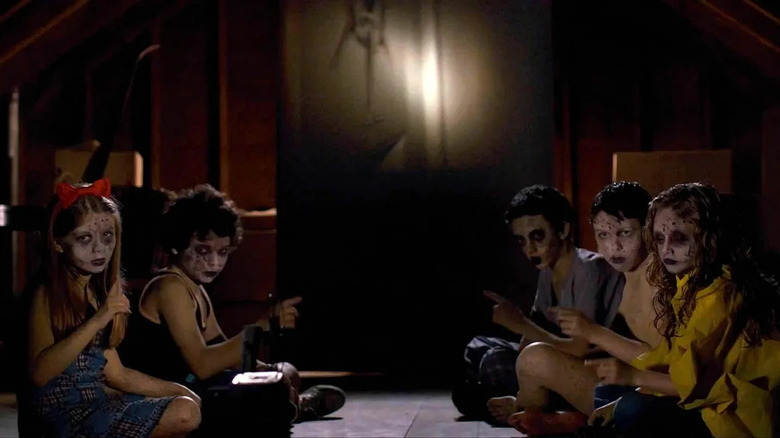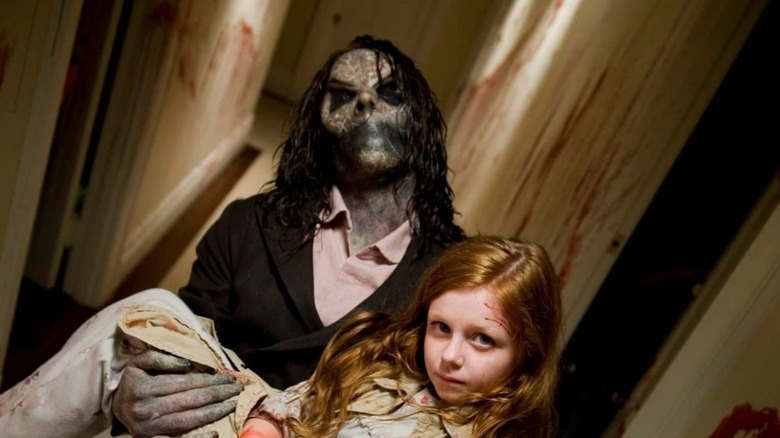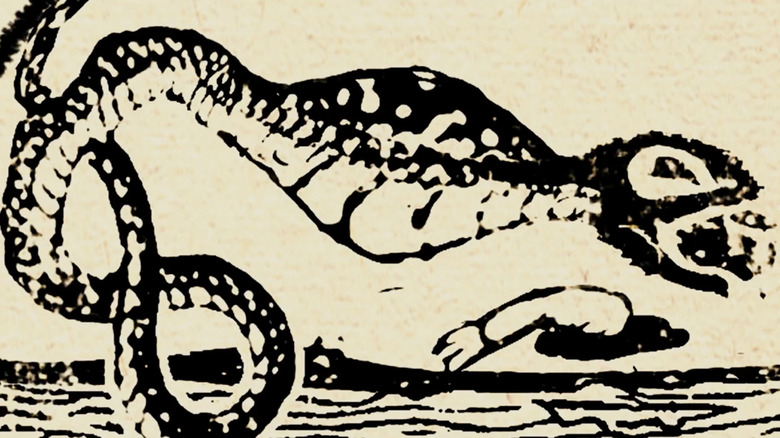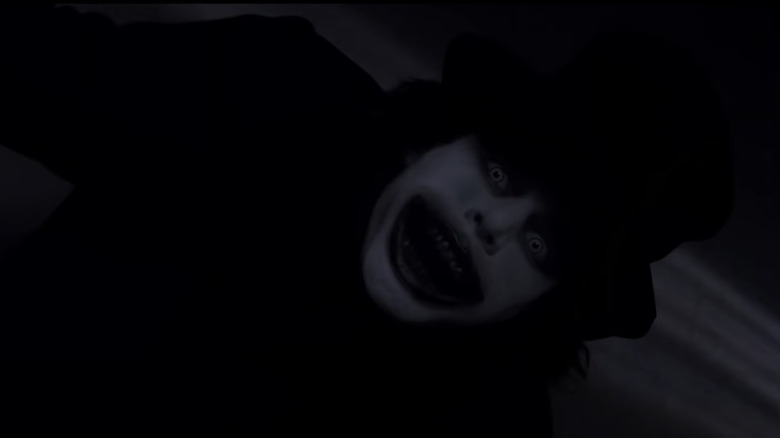Sinister's Bughuul Originally Looked Just Like The Babadook – Until The Internet Provided A Different Solution
What's a ghost story worth without a scary ghost? In "Sinister," there are six of them. Five are the specters of long-dead children, each of whom murdered their families before being spirited away. The scariest one of all is their master, Bughuul. "Mr. Boogie," as his servants call him, is an ancient deity who sustains himself by corrupting and devouring the souls of children. Portrayed by actor Nick King, the villain doesn't say a word and his screen time is scant. However, his blank searing expression makes for effective jump scares, which are often close-ups of his face.
For /Film's new 10-year anniversary oral history of "Sinister," Ryan Scott spoke with the film's director Scott Derrickson and screenwriter C. Robert Cargill. The two shed some light on the development of Bughuul, both from a narrative and design perspective.
Sinister's roots
Cargill has said in the past that "Sinister" was inspired by a nightmare he had after watching "The Ring" — that's why the films share the same spooky gimmick of cursed films:
"I was climbing into my attic when I saw a box with Super 8 films and a projector in it. I spooled up the first film and it was the opening image of 'Sinister.' That nightmare stuck with me for a while and eventually I realized it might make a for a pretty good horror movie."
The scene recreating this nightmare was surely terrifying. To make a film, though, you need more than a scene, you need a story. That's what stumped Cargill: explaining who would make these snuff films in the movie, especially since he felt, "You've got to have an answer that's better than what's in your audience's head." He eventually devised it being a missing child from each murdered family, but then needed a motive for the kids. That's when he came up with the idea of a supernatural influence.
Early in "Sinister," Ellison Oswalt (Ethan Hawke) discovers five Super 8 snuff films. Reviewing them for his book on the killings, he discovers a brief appearance by Bughuul in each. This culminates in a genre-defying twist: "Sinister" isn't a haunted house story. Images of Bughuul are gateways from his realm to the mortal one and that's why he compels the children to film the murders; with each new film, his influence spreads.
Once Cargill had an idea for his villain down, he needed to nail down specifics, both in design and backstory.
Finding Mr. Boogie
Cargill originally wanted form to reflect function in Bughuul; since the villain's goal is to ensnare young children, he pitched to Derrickson that Bughuul should look like a "f*****-up Willy Wonka." They ultimately decided to go in a different direction and Derrickson scoured the internet for inspiration.
As Derrickson told /Film, once he narrowed his selection down to five images, he passed them along to Cargill so the writer could weigh in. Derrickson recalled:
"There was a photograph, it was just called 'Natalie.' I don't know why, but it was an image off Flickr. [Cargill's] like, "I really like this Natalie image." So then as I started to work on it, the more I looked at it, I was like, 'This thing's f****** scary. It's really great.' The more I looked at it, the more I thought, 'Well, what if it's just exactly this?' I contacted the artist on Flickr and bought it for $500. And that's Bughuul."
Side note: Derrickson noted that at the time he was researching designs for Bughuul, he "was taken with a lot of black metal face paint that was being done at the time and had been done in the '90s." That might be why he chose a design that resembles Slipknot guitarist Mick Thomson.
A deity, not a demon
Derrickson and Cargill also decided that Bughuul should not be a run-of-the-mill demon. When Derrickson suggested an "ancient deity" instead, Cargill was taken with the idea and did some research himself. As he told /Film:
"I literally sat down for a couple days with my research library and just started going through Babylonian myths and Babylonian stories of Babylonian gods and demons, and crafted this idea based upon how they crafted their stories so that it sounded like it was a real Babylonian deity and took it to Scott. Scott loved it and we went forward with it."
"Sinister" is peppered with little details and backstory that make Bughuul seem like a real deity that has faded into legend. For one, he has his own insignia, moniker ("the Eater of Children"), and animals who he's associated with: dogs, snakes, and scorpions. During "Sinister," Ellison contacts Professor Jonas (Vincent D'Onofrio), an expert on the occult. Jonas explains the myths of Bughuul while unaware that Ellison has stumbled upon their root.
Mr. Boogie ... I mean Mr. Babadook
Bughuul's character still functions as something of an "evil Willy Wonka," but the "Natalie"-inspired design doesn't reflect that. In an interesting coincidence, Cargill claims that the titular monster of "The Babadook" resembles what he originally had in mind for Bughuul.
"Mr. Babadook" is kept mostly in shadow, but there are brief, terrifying glimpses of his appearance. The face is more human-like than Bughuul's, with a mouth and normal-shaped eyes. However, the white skin, black teeth and lips, and gray eyes make it clear the monster isn't human. He also wears a top hat (which is probably why Cargill compares the design to his Wonka version of Bughuul) and a black long coat similar to the final Bughuul. The Babadook's hands and his long, thin claws of fingers are his most demonic trait.
Now again, this resemblance is a coincidence. The Babadook's design was inspired by Lon Chaney's appearance in "London After Midnight," and Bughuul's original design never made it out of Cargill's mind. However, the overlap shows how some monster designs are so scary, two artists can come upon them independently.




